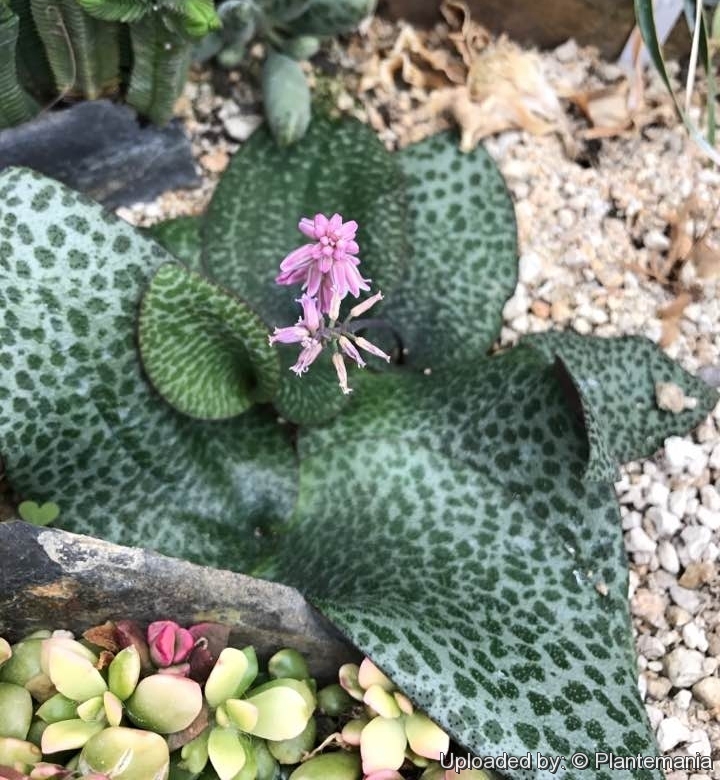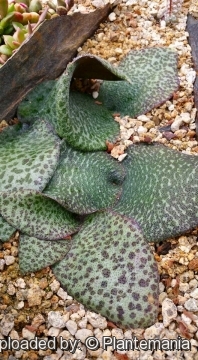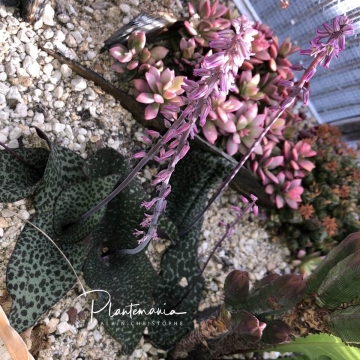
Resnova megaphylla Photo by: © Plantemania
Origin and Habitat: Resnova megaphyllaSN|33617]]SN|33617]] is native of eastern Transvaal (Mpumalanga and Limpopo provinces) in South Africa. The species is found growing quite abundantly in a restricted area of hills just within the eastern boundary of the Sekhukhuneland centre of floristic endemism.
Synonyms:
Description: Resnova megaphyllaSN|33617]]SN|33617]] is perhaps the most commonly grown species in the genus. The eight centimetres long leaves, are heavilly spotted purple and will lay flat on the ground. The plant breaks dormancy in spring and flowers right away. The dark pink flower will get 20 centimetres high.
Bulb: Leafless in dry winter dormancy, mostly buried undrground.
Leaves: Usually two, but occasionally only one or three, large, fat, oval shaped, 8-12.5 cm long, to 10 cm wide, laying flat on the ground. The leaves are, waxy-looking, well spotted in purple, inky blackish mauve or rich chestnut. Many leaves have underlying secondary spotting of pale slate and ashy grey. The leaves surface is slightly rough, covered by tiny hair in the upper surface, and are almost smooth and purplish-tinted underneath. They appear in spring and continue to grow throughout the summer.
Flowers: The flowers are white inside with rosy bands on the outside.
Bibliography: Major references and further lectures
1) Pacific Bulb Society “Resnova” web <http://pacificbulbsociety.org/pbswiki/index.php/Resnova>
2) Shields Gardens Ltd. Bulbs from Westfield “The Genus Resnova” web http://www.shieldsgardens.com/amaryllids/Resnova.html
 Resnova megaphylla Photo by: © Plantemania
Resnova megaphylla Photo by: © Plantemania Resnova megaphylla Photo by: © Plantemania
Resnova megaphylla Photo by: © PlantemaniaCultivation and Propagation: Resnova megaphyllaSN|33617]]SN|33617]] is a lovely undemanding species and is one of the most popular bulb plants. It is a summer grower and can be grown in a well drained mix. This attractive bulb has purple-spotted foliage that emerges in the spring. It is an attractive plant in the garden when used in mass or in pockets within a rock garden and also is an easy to grow houseplant. Always a favorite carefree windowsill citizen, an excellent addition to any dish garden.
Exposition: Likes light shade to part sun (it will take a few hours of sun without a problem), but adapts very well to heavy shade. Likes a bit of shade for best colour in leaves.
Watering: During the summer growing period the plant appears to need much more water than the average succulent. It does fine with year-round water. Let it dry completely between waterings.
Soil: Grow pot-bound in cactus and succulent soil (peat, perlite, pine bark), but it adapts to a wide array of garden soils. This plant needs well-drained soil; it does not like wet feet. It prefers to have the bulb buried.
Fertilization: Feed monthly with 50% strength soluble house plant food when it is actively growing.
Hardiness: The species is winter deciduous and can take light frost but not a hard freeze, so best kept in a frost free place indoors and can be grown outside where there is no danger of frost. It is often recommended to USDA zones 8-10 and should be considered good to Zone 7b too.
Pests and diseases: Slugs and snails don't seem to want to attack this plant as much as they do your traditional hosta plant.
Propagation: It's very easy to grow and to propagate. Just separate the bulbs. Seeds or (usually) by division of bulb-clusters. Will multiply in the garden to form clumps that should be divided every few years.













